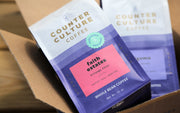If you’re shopping for a new grinder, looking to purchase a new burr set, or simply seeking to understand the inner workings of one of these machines, it’s helpful to understand the components that make each burr coffee grinder and burr set unique.
Read on to explore how different burrs can impact a grinder and the coffee that runs through it!
If you want a primer on grinding, check out our blog on choosing grind size.
Burr Grinders: What They Do And Why They Matter
It’s important to use a burr coffee grinder, rather than a blade coffee grinder. Blade grinders—powered by small, blender blades—inconsistently chop coffee particles, resulting in an uneven, uncontrollable distribution of coffee particles. Anyone who’s owned one of these grinders will know the dilemma of finding espresso powder in one portion of the grinder, while a whole bean sits untouched on the other side.
Burr grinders contain two blades with adjustable spacing, making it easy to control the coffee’s particle size. The two burrs crush coffee repeatedly during the grinding process, breaking the beans into chunks before finishing them as consistently sized particles. The brewer can adjust the spacing of these burrs, changing the size of the coffee grounds from fine (small) particles to coarse (large) particles.
While most coffee reaches the desired grind size, a small percentage of the ground coffee becomes fines. These ultra-small particles—less than 200 microns—are produced every time the coffee fractures. The specific combination of these different particle sizes is called the coffee’s particle size distribution.
Burr Material
Stainless steel is the most common medium used to make burrs, although ceramic burrs are relatively common, particularly in home grinders. Regardless of the material, the blades will wear with usage, resulting in dull edges that reduce consistency among coffee grounds. Fortunately, many manufacturers sell replacement burrs that can be swapped out with relative ease. These companies may also recommend intervals for changing your burrs, dependent on pounds of coffee ground. Check with your grinder’s manufacturer for support with changing burrs.
Two Main Types Of Burrs
There are two categories of commercial burrs: flat and conical. Flat burrs appear as two discs, with one fixed to the grinder’s body and the other attached to a moving burr carrier. Conical burrs take their name from an inner blade, which tapers upward to a point and is connected to the grinder’s motor by a drive shaft. It’s surrounded by an outer burr, set like a collar around the moving piece. In both instances, one burr moves to change spacing while the other spins to grind the coffee.

These different shapes result in radically different results—pronounced enough that experienced baristas can taste the difference between coffees brewed on different burr sets. As a general rule, conical burrs produce more fines, while flat burrs produce a more even distribution of coffee particles. With more fines, coffee ground on conical burrs tends to make more full-bodied cups, which can be particularly ideal for brew methods like espresso. The uniform grind of a flat burr generally results in lower astringency in the cup.
Burr Geometry
Within either category of flat or conical burrs, there may still be variation as a result of burr geometry. The pattern of blades impacts the distribution of coffee particle sizes produced. Between different brands and models of grinders, it’s common to see drastic variation in burr geometries, as different motors and grinder bodies can necessitate different approaches to grinding.
In recent years, after-market burrs have become more prevalent, targeting different particle distributions for the ultimate customization of grinding results. Before using aftermarket burrs, always check with your grinder manufacturer to guarantee these new parts won’t present challenges to the grinder’s functionality or existing warranty.
Burr Spacing and Alignment
Regardless of the type of burr in your grinder, it’s vital to ensure your burrs are appropriately spaced and aligned.
Throughout a grinder’s usage, burrs tend to drift apart from one another, resulting in a coarsening of all grind settings. To correct spacing, set the dial to zero and bring the burrs together until one hears a “chirping” sound. This high-pitched noise indicates contact between the burrs, meaning they can get no closer together. One should increase the burr spacing just enough that this sound stops.
If you plan to calibrate a home grinder, contact the manufacturer for support. If you work in a cafe that serves Counter Culture Coffee, please contact one of our technicians to provide this service.
If a grinder has experienced significant jostling, it may be necessary to align the burrs. When burrs are misaligned, resulting coffee grounds will display inconsistent sizing, and burrs may make unintended contact with pieces of the machine, damaging the grinder. If a grinder is out of alignment, contact a professional for assistance in correcting the issue.
While many grinders are capable of producing excellent coffee, it’s important to understand how your burrs impact the grounds. Before making substantial changes to your grinder, make sure to check in with the manufacturer. Please also remember: any time you open up a grinder, remove the plug from its power source for best safety practices.







